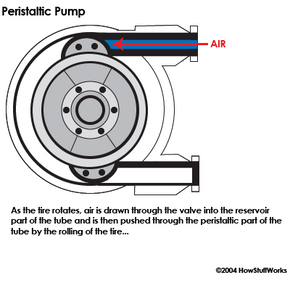The Future of Self-inflating Tires
Michelin is working with several other companies to develop an active pressure-management system called TIPM (Tire Intelligent Pressure Management), due to be available sometime in 2005. This system has a compressor that automatically adjusts the pressure in each tire while the vehicle is in operation to compensate for leaks and slow-leak punctures. The driver will be able to adjust the pressure depending on the desired driving mode: comfort, sporty, all-terrain or over-obstacle.
There are at least two other systems in the early development stages that are oriented toward the consumer market -- the EnTire system and the Cycloid AirPump system.
Advertisement
The EnTire Self-Inflating Tire system uses a valve that pulls in air from the atmosphere. It then pumps the air into the under-inflated tire using a peristaltic-pump action. The goal is to constantly maintain a specific pressure.
The AutoPump tire-inflator system by Cycloid has a small, wheel-hub-mounted pump that is powered by the turning of the wheels. When the system's monitor detects a drop in pressure of 2 to 3 psi, it pumps air into the underinflated tire. AutoPump has a warning system that is activated when there is a puncture.
For more information on self-inflating tires and related topics, check out the links below.
Self-Inflating Tires FAQ
How do self-inflating tires work?
Can a tire inflate on its own?
Can I inflate tires at gas station?
What is the proper tire inflation?
Should you inflate tires to max PSI?
Related HowStuffWorks Articles
More Great Links
- Nakano Self-Inflating Bicycle Tires
- ArvinMeritor MTIS
- GM Goodwrench Videos
Sources
- EnTire
- Got Air? Wacky Weather Wages Tire Woes
- Trends in Japan: Building a Better Bicycle
- Lynch Hummer: Central Tire Inflation
- Roadranger: Central Tire Inflation System Goodyear Investor Relations: 2001 Annual Report
- Meritor Tire Inflation Systems (MTIS) by P.S.I
- Dana Spicer Tire Management Systems
- CM Automotive Systems: CTIS Specs
- U.S. Department of Transportation: 49 CFR Part 571
- CarandDriver.com: The Anti-Geneva Show
- Heavy Duty Trucking: Air Apparent
- LandLine: Tire monitoring and inflation systems
- Gerald's Hummer Page: Central Tire Inflation System
- The Groves: U.S. Army Trucks To Feature New Technology from Dana Corp.
- Michelin Innovation in Tire Electronics
- "Surface rutting of thin pavements and gravel roads under standard and reduced tire inflation pressures," by Ahmed Shalaby and Alan Reggin, Canadian Journal of Civil Engineering, 29, 679-691, 2002.
- "Under (Controlled) Pressure," by Carol Ludorf, Transportation Communications, Fleet Equipment, August 2002.
- "Air as Needed," by David Cullen, Fleet Owner, September 2003.
- Integrated Publishing: Central Tire Inflation System
- Forester.net: Breathing New Life Into Your Tires
